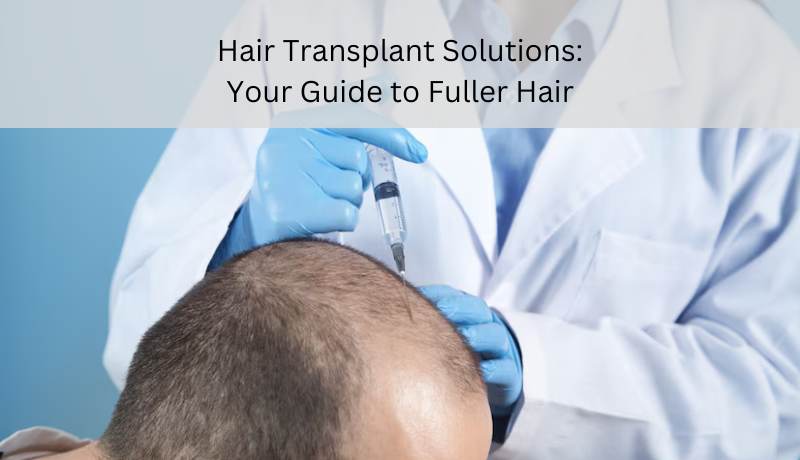
Hair loss can be a challenging experience, impacting self-esteem and confidence. For those seeking effective solutions, hair transplant solutions offer a promising remedy. This comprehensive guide explores everything you need about hair transplant procedures, empowering you to make informed decisions about restoring your natural hair.
Introduction to Hair Transplant Solutions
Hair transplant solutions encompass a range of procedures designed to combat hair loss and restore fullness to thinning areas. Whether you’re dealing with male pattern baldness, alopecia, or hair thinning due to genetic factors, these treatments aim to rejuvenate your appearance and boost your self-confidence. Choosing the right treatment requires understanding your hair loss condition and consulting a qualified specialist.
Types of Hair Loss
Hair loss can present in multiple forms, each necessitating a customized treatment strategy. The most common type, androgenetic alopecia—often referred to as male or female pattern baldness—is marked by a receding hairline and thinning at the crown, primarily caused by genetic factors and hormonal changes. Other types include alopecia areata, an autoimmune disorder causing patchy hair loss, and telogen effluvium, which results from stress, illness, or hormonal fluctuations.
Benefits of Hair Transplant
Beyond cosmetic improvement, hair transplant solutions offer profound benefits for individuals struggling with hair loss. Restoring a full head of hair can significantly enhance self-esteem and quality of life. Many patients feel more youthful and confident after successful hair transplant procedures.
Moreover, hair transplant solutions provide a permanent solution to hair loss. Unlike temporary remedies such as medications or topical treatments, which may require ongoing maintenance, a hair transplant involves transplanting healthy hair follicles from donor areas to thinning or balding areas. Once transplanted, these follicles grow naturally, blending seamlessly with your existing hair.
Different Techniques in Hair Transplant
Two primary techniques dominate modern hair transplant procedures: Follicular Unit Extraction (FUE) and Follicular Unit Transplantation (FUT).
Using a specialized extraction tool, FUE involves harvesting individual hair follicles from a donor area, usually at the scalp’s back or sides. This minimally invasive technique leaves tiny puncture marks that heal quickly without visible scarring. Each follicle is meticulously transplanted into recipient sites on the scalp, ensuring natural-looking results.
On the other hand, FUT involves removing a small strip of scalp from the donor area and meticulously dissecting it into individual follicular units under a microscope. While slightly more invasive than FUE, FUT can yield more grafts in a single session, making it suitable for extensive hair loss cases. The donor site is closed with stitches, resulting in a linear scar that the surrounding hair can hide.
Choosing between FUE and FUT depends on factors such as the extent of hair loss, donor hair availability, and personal preference. Consulting with a skilled hair transplant specialist will help determine the most appropriate technique for achieving your desired results.
Choosing the Right Clinic
Selecting a reputable hair transplant clinic is paramount to the success of your procedure. Consider the following factors when researching potential clinics:
- Experience and Credentials: Ensure the clinic is staffed by qualified surgeons with extensive experience in hair restoration.
- Patient Reviews and Testimonials: Read reviews from previous patients to gauge their satisfaction and results.
- Technology and Facilities: Look for clinics with state-of-the-art technology and comfortable facilities for optimal patient care.
- Consultation Process: A thorough consultation is essential to evaluating your suitability for a hair transplant and setting realistic expectations.
Feel free to schedule consultations with multiple clinics to compare services, ask questions, and make an informed decision.
Preparation Before the Procedure
Before undergoing a hair transplant, your specialist will conduct a comprehensive evaluation to ensure you’re a suitable candidate for the procedure. This assessment includes:
- Medical History Review: Discuss any medical conditions, medications, or allergies that may impact your surgery or recovery.
- Scalp Assessment: Evaluate the quality and density of your donor’s hair and identify suitable recipient areas for transplantation.
- Discussion of Expectations: Communicate your aesthetic goals and expectations for the procedure to align with realistic outcomes.
Preparing mentally and physically for your hair transplant involves understanding the procedure’s steps, potential risks, and expected recovery process. Your specialist will provide detailed pre-operative instructions to optimize your experience and results.
Cost Considerations
The hair transplant cost varies depending on several factors, including the clinic’s location, the surgeon’s expertise, the chosen technique (FUE or FUT), and the number of grafts required. While cost is significant, prioritize quality and safety when selecting a clinic and surgeon.
Some clinics offer financing options or payment plans to make hair transplant solutions more accessible to patients. Discuss financial considerations during your consultations to find a solution that fits your budget without sacrificing the quality of care.
Read More: Top Hair Implant Solution for Thinning and Balding Hair
Conclusion
Hair transplant solutions offer a reliable path to regaining fuller, thicker hair and boosting self-confidence. Whether you’re experiencing early signs of hair loss or significant balding, consulting with a qualified hair transplant specialist can help you find the most suitable treatment plan for your needs.
RELATED POSTS
View all


